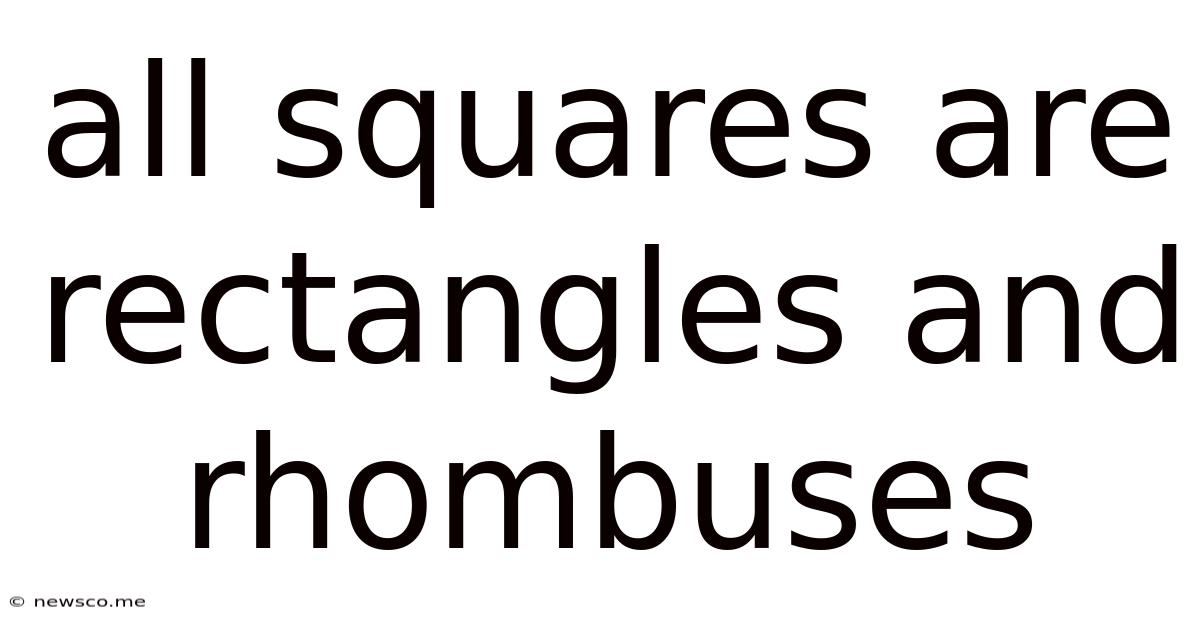All Squares Are Rectangles And Rhombuses
News Co
Mar 29, 2025 · 4 min read

Table of Contents
All Squares Are Rectangles and Rhombuses: A Deep Dive into Quadrilateral Geometry
Understanding the relationships between different types of quadrilaterals can be a cornerstone of geometric understanding. This article delves into the fascinating world of quadrilaterals, focusing specifically on the inherent properties that establish the undeniable truth: all squares are rectangles, and all squares are rhombuses. We'll explore the defining characteristics of squares, rectangles, and rhombuses, highlighting the hierarchical nature of their relationships through detailed explanations and illustrative examples.
Defining Our Key Quadrilaterals
Before we dive into the proof, let's solidify our understanding of the three key quadrilaterals: squares, rectangles, and rhombuses.
1. Squares: The Perfect Quadrilateral
A square is a remarkable quadrilateral defined by four key properties:
- Equilateral: All four sides are of equal length.
- Equiangular: All four interior angles are right angles (90 degrees).
- Parallelogram: Opposite sides are parallel.
- Cyclic: All four vertices lie on a single circle.
The square embodies perfect symmetry, possessing both rotational and reflectional symmetry. Its properties make it a special case within the broader families of rectangles and rhombuses.
2. Rectangles: Defined by Right Angles
A rectangle is a quadrilateral characterized by:
- Equiangular: All four interior angles are right angles (90 degrees).
- Parallelogram: Opposite sides are parallel.
Notice that a rectangle doesn't require equal side lengths. This is the crucial difference that distinguishes it from a square. While all squares are rectangles, not all rectangles are squares.
3. Rhombuses: Defined by Equal Sides
A rhombus is a quadrilateral with:
- Equilateral: All four sides are of equal length.
- Parallelogram: Opposite sides are parallel.
Unlike a square, a rhombus doesn't necessitate right angles. Its angles can vary, making it a more general case than a square. Again, all squares are rhombuses, but not all rhombuses are squares.
The Proof: Why All Squares Are Rectangles and Rhombuses
The relationships between squares, rectangles, and rhombuses are hierarchical. This means that a square inherits all the properties of both rectangles and rhombuses. Let's break down why:
All Squares Are Rectangles:
A square possesses all the defining characteristics of a rectangle. Since a square has four right angles (equiangular) and its opposite sides are parallel (parallelogram), it perfectly satisfies the definition of a rectangle. Therefore, every square is a rectangle.
All Squares Are Rhombuses:
Similarly, a square possesses all the characteristics of a rhombus. A square has four sides of equal length (equilateral) and opposite sides are parallel (parallelogram). This fulfills the definition of a rhombus. Thus, every square is a rhombus.
Visualizing the Relationships: Venn Diagrams and Set Theory
We can effectively visualize these relationships using Venn diagrams. Imagine three overlapping circles: one for squares, one for rectangles, and one for rhombuses. The circle representing squares would be entirely contained within both the rectangle and rhombus circles. This illustrates that the set of squares is a subset of both the set of rectangles and the set of rhombuses.
This concept is fundamentally rooted in set theory. The set of squares is a proper subset of both the set of rectangles and the set of rhombuses. This means that all elements of the square set are also elements of the rectangle and rhombus sets, but not vice-versa.
Exploring Further: Other Quadrilaterals and Their Relationships
Understanding the relationships between squares, rectangles, and rhombuses provides a strong foundation for exploring other quadrilaterals. Let's briefly touch upon some others:
- Parallelograms: Rectangles and rhombuses are specific types of parallelograms. A parallelogram simply requires opposite sides to be parallel.
- Trapezoids (Trapeziums): These quadrilaterals have at least one pair of parallel sides.
- Kites: These have two pairs of adjacent sides that are equal in length.
These quadrilaterals are all connected through shared properties and hierarchical relationships. Understanding the broader classification helps to appreciate the unique characteristics of each shape.
Real-World Applications: Where Do We See These Shapes?
The geometric principles governing squares, rectangles, and rhombuses are fundamental to many aspects of our world. We encounter these shapes everywhere:
- Architecture: Buildings often utilize rectangular and square designs for structural integrity and aesthetics.
- Engineering: Many engineering designs, from bridges to microchips, incorporate these shapes for optimal functionality.
- Art and Design: Squares and rectangles are fundamental components of visual art and graphic design, providing structure and balance.
- Everyday Objects: From books and windows to tiles and playing cards, these shapes are ubiquitous in our daily lives.
Conclusion: The Importance of Geometric Understanding
This exploration of the relationship between squares, rectangles, and rhombuses highlights the power of precise geometric definitions and logical reasoning. Understanding these hierarchical relationships is not merely an academic exercise; it's a crucial component of problem-solving in various fields. The ability to identify and categorize shapes based on their properties is a fundamental skill that extends far beyond the classroom. By strengthening our understanding of fundamental geometric concepts, we open doors to a deeper appreciation of the world around us and the underlying mathematical principles that govern it. This deeper understanding allows for greater innovation and problem-solving in diverse fields. The seemingly simple relationship between a square, rectangle, and rhombus serves as a powerful testament to the interconnectedness of mathematical concepts and their practical applications in the real world.
Latest Posts
Related Post
Thank you for visiting our website which covers about All Squares Are Rectangles And Rhombuses . We hope the information provided has been useful to you. Feel free to contact us if you have any questions or need further assistance. See you next time and don't miss to bookmark.